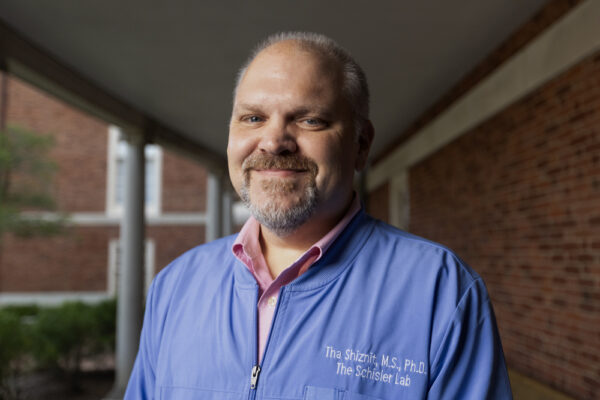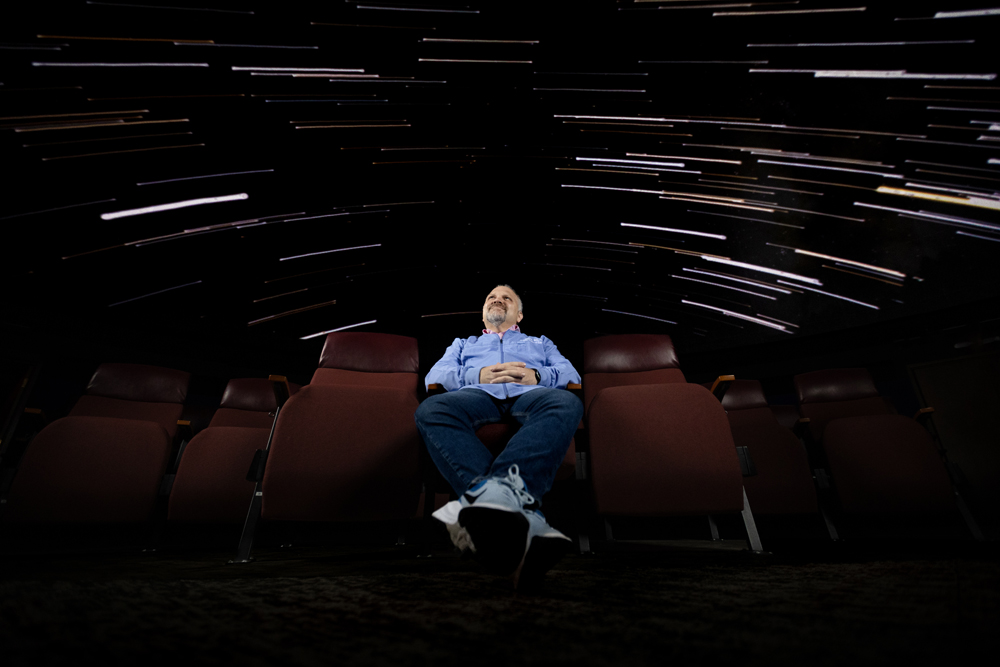In 1986, four teenagers attending a NASA space camp in Huntsville, Alabama, were accidentally launched into space while participating in an engine test on a shuttle. They put their brief training to use and miraculously made their way back to Earth before running out of oxygen.
This is the premise of the movie “Space Camp” — a childhood favorite of UNC-Chapel Hill researcher Jonathan Schisler.
“NASA was so cool when I was a kid,” Schisler says, chuckling. “I watched that movie a gazillion times and wanted to go to space camp so badly.”
He never made it to space camp, but his dad brought home a NASA shuttle manual that included a laminated image of the shuttle controls. Schisler would sit in his garage with the page in front of him while listening to a cassette tape he’d recorded of the NASA shuttle launch, pretending he was manning the spaceship.
“So I was totally freaked out when NASA Day came to UNC,” he says.
In 2019, NASA came to campus as part of the first-ever University Research Week — an annual celebration of Carolina’s research excellence and an effort to engage students in research activity. NASA Day included presentations and workshops on how to work with the space agency, details about the Artemis mission to the moon, and exposure to collaborative research opportunities. Zena Cardman, an alumna and astronaut candidate, gave the keynote address.
“I just wanted to get a couple of stickers for my kids — but then the talks were amazing, and it opened up this whole other world,” Schisler shares.
NASA scientists were particularly interested in Schisler’s research on aging. He studies how aging impacts human health and disease, specifically in the heart and the brain, through observing the mechanisms that control metabolism and protein quality.
This work translates well to NASA during what’s being called the “Second Space Age,” as private companies like SpaceX and Blue Origin are making spaceflight accessible to the public. Long-term spaceflight, in particular, can wreak havoc on the body, and some research suggests it might accelerate aging and lead to symptoms like muscle degeneration, vascular and metabolic changes, and bone loss.
“I was all for going to space until I started analyzing the data,” Schisler says. “Even the most common hazards, like weightlessness and radiation exposure, are problematic.”
It can also disrupt sleep patterns, alter vision, and affect mental health.
Five years later, Schisler has co-authored multiple papers with NASA scientists and is continually collaborating on projects. And now, he’s trying to create a space research center at Carolina, which could become the East Coast hub for a series of these centers across the U.S.
From genes to proteins
In the late 1990s, after earning his biology degree, Schisler began working for the Human Genome Project — a famous effort to sequence all the genes in the human genome — at Argonne National Laboratory in Chicago.
“I was sitting there loading these old-school DNA sequencing gels that took 18 hours to run. That was my job — just building on the human genome,” Schisler says with a smile. “And that’s when I realized this is what I want to do. I figured out my path.”
After earning a master’s degree in bioengineering and a PhD in biological chemistry, Schisler came to Carolina in 2006 for a postdoctoral research position. He worked in the lab of Cam Patterson, a cardiologist who was studying heart failure and atherosclerosis, a chronic heart disease caused by plaque build-up in the arteries.
“I wanted to learn a new organ system and get more skills,” Schisler shares. “And the great part of training with an MD was that I was able to work in the clinical research space.”

Jonathan Schisler (photo by Alyssa LaFaro)
Schisler began studying protein quality control. The heart functions, in part, from new proteins created each week to help it continue beating. But sometimes, those proteins stop working and begin to aggregate into plaques, which can lead to heart failure. Protein build-up also occurs in the brain and is associated with diseases like Parkinson’s, amyotrophic lateral sclerosis (ALS), Huntington’s, frontal temporal dementia, and Alzheimer’s.
Schisler wanted to know where things go wrong in the protein production process — and if there’s a way to stop it.
His first project at Carolina looked at a heart protein called CHIP that recruits other proteins into groups and helps them either restructure or trigger their disposal. Could CHIP be used to break down proteins that aggregate in other parts of the body like the brain?
In 2016, when Carolina neuroscientist Todd Cohen read Schisler’s paper on this research, he wondered exactly that. Schisler and Cohen began collaborating in 2016 and eventually received an award from the National Institute on Aging to figure out how their combined research might aid treatments for Alzheimer’s disease.
“I have a lot of irons in the fire,” Schisler says with a laugh. “People always tell me I should just focus on one thing. That’s not me.”
To infinity and beyond
Another disease Schisler studies is spinocerebellar ataxia, a progressive neurological disease where the cerebellum — the back of the brain that controls fine motor skills, gait, and balance — weakens with age.
The disease is the result of a mutated gene — the same gene that makes CHIP — that accelerates aging, and clinicians have yet to fully understand it. There is no cure, but with the continued research of Schisler and other scientists around the world, there could be one day.
Schisler’s first project with NASA looked at astronaut RNA data that showed mitochondria damage from spaceflight. Mitochondria produce energy that helps cells function and, ultimately, power the body. Tiny versions called microRNAs, were found in the bloodstream and appeared to facilitate communication across organs, triggering mitochondrial damage and affecting how proteins are made.
For the next experiment, Schisler worked with Afshin Beheshti, director of the Space Biomedicine Program at the University of Pittsburgh, to test small synthetic nucleic acid molecules called antagomirs. Designed to bind to those same microRNAs triggered by spaceflight, these molecules can block and protect mitochondria from damage.
Schisler is also studying the effects of moon dust on astronaut health. Some data suggests it’s just as dangerous as coal dust and could impact how mitochondria generate energy. Another project is assessing the causes of “space fog” — or brain fog — in astronauts, thought to develop from the physical and emotional stressors of being in space.
Since attending NASA Day in 2019, Schisler has worked on seven papers with NASA scientists and became the first Carolina researcher to submit data to the Space Omics and Medical Atlas, a repository of studies related to spaceflight from over 100 institutions worldwide. And now, he’s trying to start a center for space science at UNC-Chapel Hill.
With support from NASA and local stakeholders like data visualization company JMP, the North Carolina Biotechnology Center, and the North Carolina Space Grant at NC State, Schisler hopes to make Carolina an East Coast hub for space science research.
UNC-Chapel Hill has a historic connection to the space agency thanks to Morehead Planetarium and Science Center, the South’s first planetarium and the training site for over 60 NASA astronauts — including Neil Armstrong and John Glenn — between 1960 and 1975. Schisler has begun discussions with the team at Morehead to build momentum for the center.
“We want to bring in people that maybe were like me a couple of years ago at NASA Day. I didn’t really know how my research program fit in the context of space biology, but now I realize the broader impacts of my research for applications in outer space and how that also benefits biology and human health here on our planet,” he says.
For Schisler, Carolina is the perfect place for a hub like this. The university is known for being highly collaborative and interdisciplinary — values that align well with NASA’s.
“If we’re going to get a North Carolina-centric space science research center it’s going to be rooted in that mentality of team science and working toward a common goal.”


